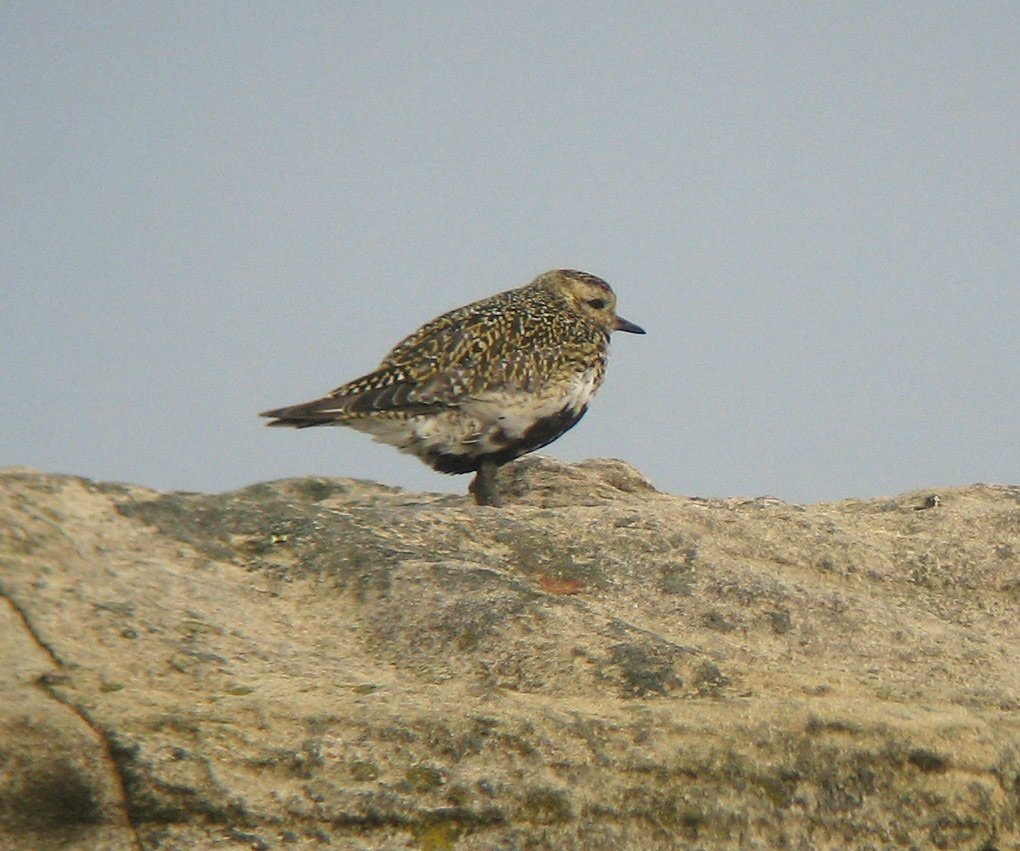- Eurasian Golden Plover
Taxobox
name = Eurasian Golden Plover
status = LC
status_system = iucn3.1

image_width = 240px
image_caption = Eurasian Golden Plover (in moult, late summer)
regnum =Animal ia
phylum =Chordata
classis =Aves
ordo =Charadriiformes
familia =Charadriidae
genus = "Pluvialis "
species = "P. apricaria"
binomial = "Pluvialis apricaria"
binomial_authority = (Linnaeus, 1758)The Eurasian Golden Plover, "Pluvialis apricaria", is a largish
plover . This species is similar to two other golden plovers.American Golden Plover , "Pluvialis dominiica", andPacific Golden Plover , "Pluvialis fulva", are both smaller, slimmer and relatively longer-legged than Eurasian Golden Plover, and both have grey rather than whiteaxilla ry feathers (only properly visible in flight).Description
Breeding adults are spotted gold and black on the crown, back and wings. Their face and neck are black with a white border; they have a black breast and a dark rump. The legs are black. In winter, the black is lost and the plover then has a yellowish face and breast and white underparts.
Breeding habitat
Their breeding habitat is moorland and tundra in northernmost parts of
Europe and westernAsia . They nest on the ground in a dry open area. They are migratory and winter in southern Europe and northAfrica . Around 500,000 birds winter inIreland andGreat Britain . Although generally common, its range has contracted somewhat in the past due tohabitat destruction . For example, in the 19th century it disappeared as a breeding bird inPoland and only occurs there as a migrant nowadays; its breeding population in Central Europe apparently was arelict of thelast ice age (Tomek & Bocheński, 2005).Feeding
These birds forage for food on tundra, fields, beaches and tidal flats, usually by sight, although they will also feed by moonlight. They eat insects and crustaceans, also berries.
Protection
* [http://www.umweltruf.de/ticker/news_druck0.php3?nummer=3134 Moorland and protection of species in west Lower Saxony]
The Eurasian Golden Plover is one of the species to which the Agreement on the Conservation of African-Eurasian Migratory Waterbirds (
AEWA ) applies.References
* Database entry includes justification for why this species is of least concern.
* Tomek, T. & Bocheński, Z. (2005). Weichselian and Holocene bird remains from Komarowa Cave, Central Poland. "Acta Zoologica Cracoviensia", "48A"(1-2), 43-65. [http://www.ingentaconnect.com/search/download?pub=infobike%3a%2f%2fisez%2fazc%2f2005%2f00000048%2fF0020001%2fart00005&mimetype=application%2fpdf PDF fulltext]
Wikimedia Foundation. 2010.
